Nestled in the heart of Ontario, Algonquin Provincial Park stretches across 7,653 square kilometers between Georgian Bay and the Ottawa River, offering one of Canada’s most iconic provincial park wilderness experiences. Located roughly 300 kilometers north of Toronto, this natural sanctuary is easily accessible via Highway 60, which bisects the park’s southern corridor. Whether you’re driving from Ottawa (3 hours west) or Toronto (3.5 hours north), well-marked routes guide you to the park’s multiple access points, with the West Gate near Huntsville and East Gate near Whitney serving as primary entrances. Beyond its convenient location, Algonquin’s position in Ontario’s transitional forest zone creates a unique meeting point between northern and southern ecosystems, making it a perfect destination for wildlife enthusiasts and outdoor adventurers seeking an authentic Canadian wilderness experience just a few hours from major urban centers.
Location and Getting There
Park Coordinates and Boundaries
Nestled in south-central Ontario, Algonquin Provincial Park spans an impressive area between Georgian Bay and the Ottawa River. The park’s main coordinates are 45.8764° N, 78.3641° W, making it easily locatable on GPS devices and maps. This vast wilderness paradise covers approximately 7,653 square kilometers (2,955 square miles), stretching roughly from Huntsville in the southwest to Deep River in the northeast.
The park shares its borders with several Ontario communities, including Whitney to the east, Dwight to the west, and Madawaska to the south. Highway 60, often called the Algonquin Corridor, runs through the southern portion of the park for about 56 kilometers, offering the most accessible route for visitors.
Fun fact: The park is so large that it’s actually bigger than Prince Edward Island! Its unique location in a transition zone between northern coniferous forest and southern deciduous forest creates an incredible mix of ecosystems. You’ll find yourself right in the heart of Ontario’s natural beauty, where the Canadian Shield meets the forests of the Great Lakes-St. Lawrence region.
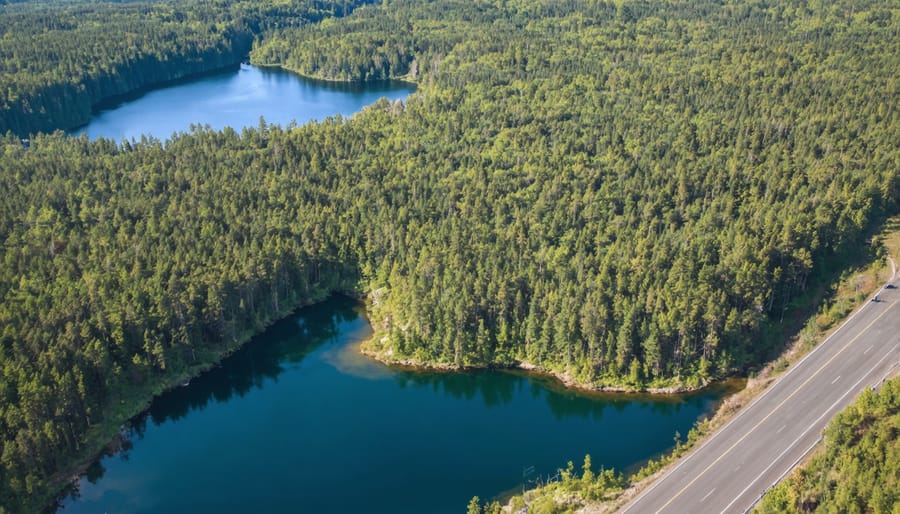
Major Access Routes
The main gateway to Algonquin Provincial Park is the Highway 60 corridor, which runs east-west through the southern portion of the park for about 56 kilometers. This well-maintained route is accessible year-round and connects to Highway 11 in the west and Highway 17 in the east, making it easy to reach from major cities like Toronto and Ottawa.
For adventurous travelers, there are several other access points scattered around the park’s perimeter. The Achray Road entrance on the east side leads to Grand Lake, while the Brent Road access point in the north opens up to Cedar Lake. The Rain Lake Road and Magnetawan Lake Road provide entry from the west, perfect for backcountry enthusiasts.
During winter, Highway 60 remains plowed and accessible, though some secondary access roads may be closed or unmaintained. If you’re planning to visit during peak fall colors (late September to mid-October), arrive early as parking lots along Highway 60 fill up quickly, especially at popular trailheads and visitor centers.
Pro tip: Consider using the less crowded western access points during busy summer weekends to avoid the main Highway 60 traffic.
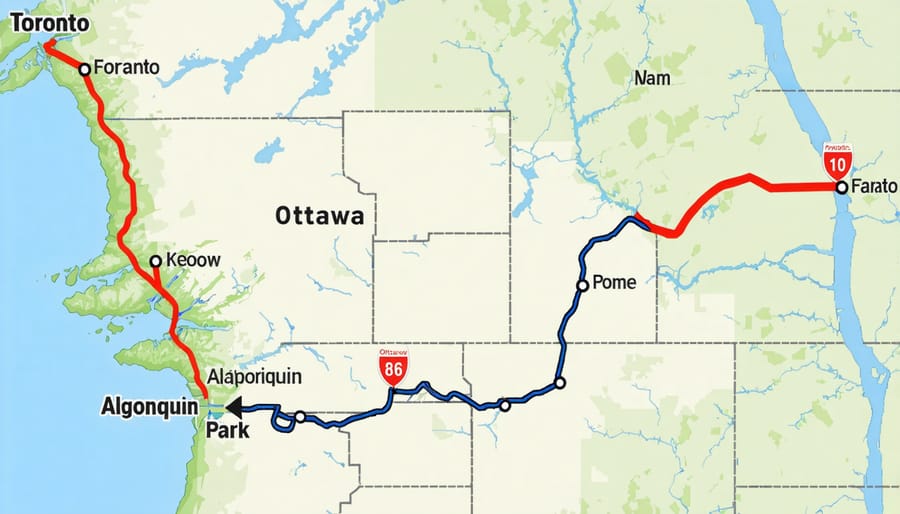
Distance from Major Cities
From Toronto and the GTA
From Toronto, getting to Algonquin Park is a straightforward journey north on Highway 400, which turns into Highway 11. At Huntsville, take Highway 60 east into the park’s West Gate. The drive typically takes about 3 hours from downtown Toronto, or around 2.5 hours from the northern GTA.
Insider tip: Leave early in the morning (before 7 AM) to avoid heavy cottage country traffic, especially during summer weekends and holidays. The best part? You’ll arrive just in time to catch the morning mist rising off the lakes.
The most scenic route follows Highway 60 through the park’s corridor, with plenty of lookout points and trail access. For a more relaxed journey, consider breaking up your drive with a stop in Huntsville for a coffee and a stretch. Remember to fill up your gas tank before entering the park, as fuel stations are limited within park boundaries.
Make sure to check road conditions during winter months, as snow and ice can affect travel times.
From Ottawa and Other Cities
From Ottawa, the park is easily accessible via Highway 17 to Highway 60, with the journey taking roughly 3.5 hours. Toronto visitors can reach the park in about 3 hours by following Highway 400 north to Highway 11, then connecting to Highway 60 east. Sudbury residents have a scenic 4-hour drive south along Highway 17 and then Highway 60.
For those coming from Montreal, plan for a 5-hour drive west along Highway 417, which becomes Highway 17 in Ontario. Visitors from North Bay can reach the park in about 2 hours by taking Highway 17 south to Highway 60.
Several shuttle services operate from major cities during peak season, and some tour companies offer direct transportation packages. If you’re flying in, the closest major airports are Ottawa International Airport and Toronto Pearson, with car rental services available at both locations.
Remember to fuel up before entering the park, as gas stations are limited within park boundaries. Consider breaking up longer drives with stops in charming towns along the way.
Park Entry Points and Permits
Main Gates and Visitor Centers
Algonquin Provincial Park welcomes visitors through several well-maintained gates, each offering unique access points to this natural wonderland. The West Gate, located on Highway 60, serves as the most popular entrance and features a comprehensive visitor center where you can learn about park history, pick up trail maps, and get your Ontario parks permit requirements. The East Gate, quieter but equally charming, provides access to the park’s eastern sections and includes basic facilities for travelers.
The main Visitor Centre, located 43 kilometers from the West Gate, is a must-visit spot to start your Algonquin adventure. Here you’ll find fascinating exhibits about the park’s wildlife, interactive displays, and knowledgeable staff ready to help plan your visit. Don’t miss the outdoor viewing deck – it offers breathtaking views of hundreds of kilometers of wilderness.
Pro tip: During peak summer months, arrive early at the West Gate to avoid queues, especially on weekends. The gates open at 8:00 AM, and getting there before 9:00 AM can make your entry much smoother.
Backcountry Access Points
For wilderness enthusiasts, Algonquin Park offers several backcountry access points scattered along Highway 60 and the park’s perimeter. The most popular entry points include Access Point 5 at Canoe Lake, perfect for both day trips and extended journeys, and Access Point 1 at Rock Lake Road, which provides a gentler introduction to backcountry travel.
The western access points, such as Rain Lake and Magnetawan Lake, offer more secluded experiences and fewer crowds, making them ideal for seasoned adventurers seeking solitude. On the east side, the Shall Lake and Brent access points serve as gateways to some of the park’s most remote territories.
Each access point has designated parking areas and loading zones for canoes and kayaks. Remember to pick up your required backcountry permits at the nearest permit office before heading out. During peak season (July-August), it’s wise to reserve your access point in advance, as popular entry locations can fill up quickly.
Pro tip: Consider less-traveled access points during busy weekends, and always check road conditions before heading to more remote entry points, especially in spring and fall.
Best Times to Visit
Seasonal Highlights
Algonquin Park offers a unique experience in each season, making it one of Ontario’s natural attractions that truly showcases the beauty of Canadian wilderness year-round.
Spring brings the magical maple syrup season and the return of migratory birds. Watch as the forest awakens with trilliums carpeting the forest floor and listen for the haunting calls of returning loons on the lakes. Mid-May to June offers excellent moose viewing opportunities along Highway 60.
Summer bursts with activity as warm days invite swimming, paddling, and hiking adventures. The lakes reach comfortable temperatures for canoeing and kayaking, while the extensive trail network provides shaded walks through lush forests. Evening programs at the outdoor theater and wildlife viewing are at their peak.
Fall transforms the park into a spectacular canvas of red, orange, and yellow hues, typically peaking mid-September to early October. This is prime time for photography and wildlife watching, with fewer mosquitoes and comfortable hiking temperatures.
Winter blankets the park in snow, creating a serene landscape perfect for cross-country skiing, snowshoeing, and winter camping. The Wolf Howl programs run during August and early September, offering unforgettable experiences under starlit skies. Remember that services are limited during winter months, so extra preparation is essential.
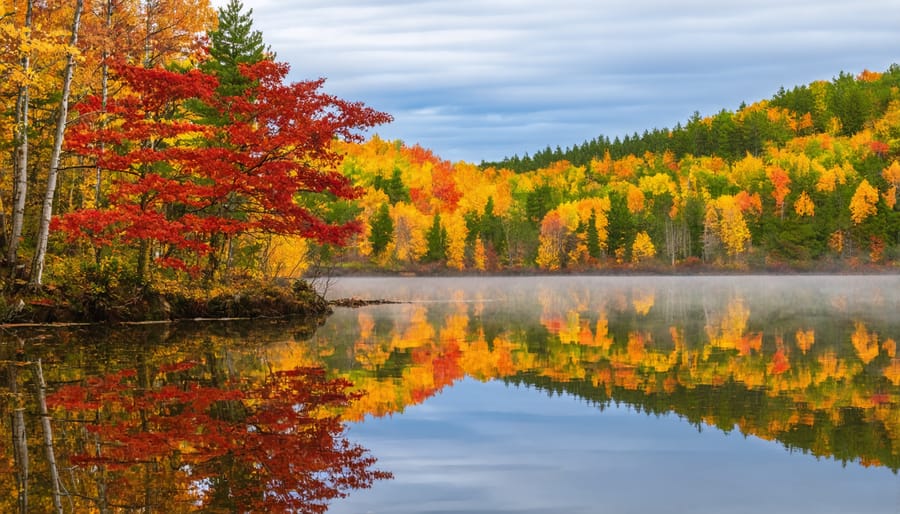
Insider Tips for Timing Your Visit
As a frequent visitor to Algonquin, I can tell you that timing is everything! For the most magical experience, plan your visit during late September to mid-October when the fall colors transform the park into a stunning canvas of reds, oranges, and yellows. Book your accommodation at least six months ahead for this peak season, as it’s incredibly popular.
Want to avoid the crowds? Early June and late August are perfect sweet spots. You’ll still enjoy warm weather for camping and hiking, but with significantly fewer visitors. Plus, the blackflies that can be pesky in May have usually moved on by then.
For wildlife enthusiasts, dawn and dusk are prime viewing times. Set your alarm early to catch moose feeding in shallow waters during spring and summer mornings. Winter visitors should aim for March when longer daylight hours and warmer temperatures make for perfect cross-country skiing conditions.
If you’re keen on water activities, August offers the warmest lake temperatures for swimming and canoeing. However, mid-week visits during July and August help you dodge the weekend crowds at popular access points and campgrounds.
Local tip: The first two weeks of September offer a hidden gem period – the weather is still lovely, most summer tourists have left, and the fall colors are just beginning to emerge. It’s my favorite time to visit!
Algonquin Provincial Park is truly a natural treasure that deserves a spot on every outdoor enthusiast’s bucket list. Before you head out, remember to book your permits well in advance, especially during peak summer months and fall colors season. Pack for changing weather conditions, as temperatures can vary significantly throughout the day. Don’t forget your camera, binoculars, and a good map – the park’s stunning wildlife and landscapes offer countless photo opportunities. Whether you’re planning a day trip or a week-long wilderness adventure, Algonquin’s accessibility from major Ontario cities makes it an ideal escape into nature. The park’s pristine lakes, ancient forests, and extensive trail network await your exploration. Come discover why generations of visitors have fallen in love with this magnificent wilderness paradise.


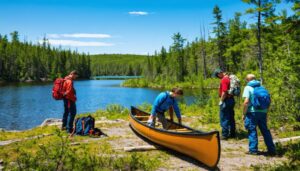



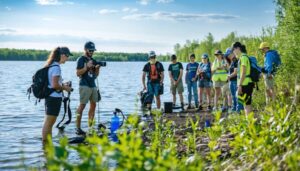


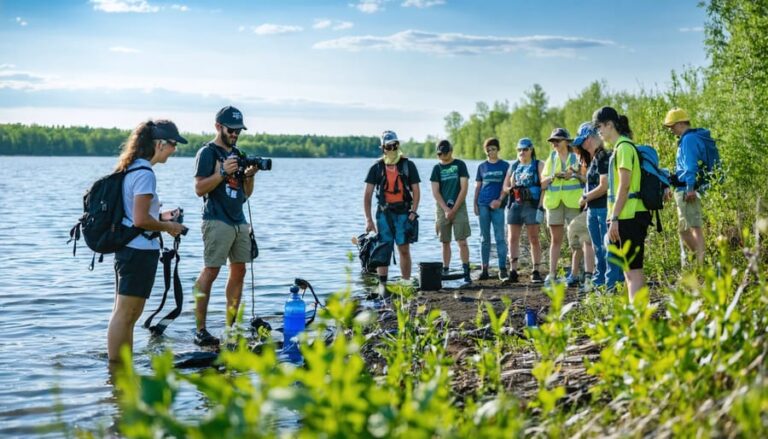




+ There are no comments
Add yours